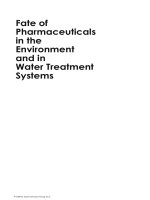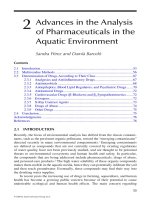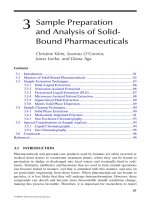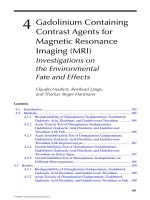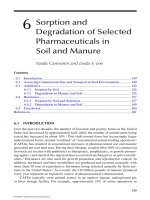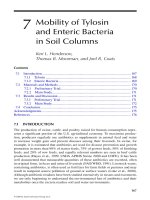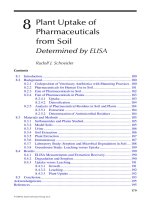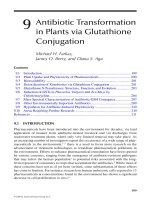Fate of Pharmaceuticals in the Environment and in Water Treatment Systems - Chapter 10 docx
Bạn đang xem bản rút gọn của tài liệu. Xem và tải ngay bản đầy đủ của tài liệu tại đây (201.53 KB, 13 trang )
Part III
Treatment of Pharmaceuticals in
Drinking Water and Wastewater
© 2008 by Taylor & Francis Group, LLC
217
10
Drugs in Drinking Water
Treatment Options
Howard S. Weinberg,
Vanessa J. Pereira, and Zhengqi Ye
10.1 INTRODUCTION
The high usage of drugs throughout the world, their partial metabolism after inges-
tion,andinconsistenciesinthewaytheyaredisposedmaketheirpresenceinthe
aquaticenvironmentinevitable.Theirsourcesinnaturalwatersarenotlimitedto
excretion of parent compounds and their metabolites by individuals and pets but also
include disposal of unused medications to sewage systems, underground leakage
from sewage system infrastructures, release of treated or untreated hospital wastes,
disposal by pharmacies and physicians, and humanitarian drug surplus to domestic
sewage systems. Transmission routes include release to private septic elds; treated
efuentfromdomesticsewagetreatmentplantsdischargedtosurfacewaters;over-
owofuntreatedsewagefromstormeventsandsystemfailuresdirectlytosurface
waters;transferofsewagesolidstoland;releasefromagriculture;dungfrommedi-
cated domestic animals and conned animal feeding operations; direct release via
washing, bathing, or swimming; discharges from industrial manufacturing and
clandestine drug laboratories, as well as illicit drug usage; leaching from defective
landlls; and release from aquaculture.
1
After release into the environment, most
pharmaceutically active compounds (PhACs) are eventually transported to the aque-
ousdomainandareexpectedtobeonlypartiallydegradedandtransformedinto
other products by phototransformative, physicochemical, and biological degradation
reactions. The environmental fate of only a fraction of these compounds has been
evaluated in laboratory studies, and only recently has their occurrence in drinking
Contents
10.1 Introduction 217
10.2 Occurrence in the Aquatic Environment 218
10.3 Drinking Water Treatment 218
10.3.1 Pretreatment 220
10.3.2 Filtrat ion 220
10.3.3 Chlorine-Based Disinfection 221
10.3.4 Ozone and Advanced Oxidation Treatment 222
10.3.5 Ultraviolet (UV) and Advanced Oxidation Treatment 223
10.4 Conclusion 225
References 226
© 2008 by Taylor & Francis Group, LLC
218 Fate of Pharmaceuticals in the Environment and in Water Treatment Systems
water been considered.
2
Their presence at low levels presents analytical challenges,
and the environmental impact and public health effects of long-term, low-level expo-
s
u
re and combinatory effects of these compounds requires further study. Particular
concern should be raised over those compounds that resist wastewater and drinking
watertreatment.TreatmentprocessesthatareexpectedtoefcientlyremovePhACs
from water include adsorption using activated carbon, ozonation, ultraviolet (UV),
and advanced oxidation processes. The concentrations investigated in laboratory-
controlled evaluations of treatment options are often higher than those expected in
the aquatic environment. This is a standard procedure in laboratory-scale studies for
determination of rate constants and other fundamental process parameters minimiz
-
ing interference and analytical constraints, since working at these levels allows the
analyte reduction to be followed over at least an order of magnitude without involv
-
ing extensive extractions or preparation procedures.
Althoughthelifetimeingestionofdrinkingwatermayresultinconsumerexpo
-
suretoPhACsatanorderofmoreorlessthanasingletherapeuticdose,l
ittlei
s
knownaboutlong-term,low-levelexposuretohumansorthepotentialsynergisms
t
h
at may arise from exposure to multiple compounds. Consequently, it is prudent to
considertheoptionsavailabletopreventPhACsfromreachingdrinkingwater.
10.2 OCCURRENCE IN THE AQUATIC ENVIRONMENT
The occurrence of different classes of PhACs, such as analgesics and antiinam-
matories, antibiotics, antiepileptics, beta-blockers, blood lipid regulators, contrast
media, oral contraceptives, cytostatic, and bronchodilator drugs, has been reported
in sewage, surface, ground and drinking water.
3,4,5–13
Maximum occurrence levels for
some of these compounds reported in different countries are presented in Table 10.1,
w
h
ichalsopresentsestimatesofquantitiesofPhACssoldforuseinhumanmedicine
inGermanyin1997,wherescripdataaremorewidelyaccessiblethanintheUnited
States,togetherwithsecondarywastewatertreatmentplant(WWTP)removalef
-
c
i
encies obtained by collecting composite raw inuent and nal efuent samples
overaperiodof6days.
3
The reported WWTP removal efciencies were highly vari-
able, and during other sampling events conducted at the same plant lower removal
efciencies were observed. These results make clear the need to investigate further
the fate and potential remediation options for those PhACs that were found to resist
wastewatertreatmentandthatwerefoundindrinkingwater,suchasclobricacid,
iopromide, carbamazepine, diclofenac, and ibuprofen.
10.3 DRINKING WATER TREATMENT
A conventional surface water treatment process that consists of coagulation, oc-
culation, sedimentation, ltration, and disinfection is often employed in drinking
watertreatmentfacilities.OzoneandUVcanbeusedasoxidantsanddisinfectants,
butchlorineandchloraminesaremostoftenemployedfornaldisinfectioninthe
UnitedStatessothatapersistentresidualismaintainedinthedistributionsystem.
© 2008 by Taylor & Francis Group, LLC
DrugsinDrinkingWater 219
TABLE 10.1
Pharmaceuticals Sold in Germany, Wastewater Removal Efficiency in Germany, and Maximum Concentrations Reported by
Several Authors in Different Countries (References Given in Parentheses)
Maximum Concentrations Reported
Compound Therapeutic Class
PhACs Sold in
Germany (Tons)
WWTP Removal
Efficiency (%)
WWTP Effluent
(µg/L)
Surface Water
(µg/L)
Groundwater
(µg/L)
Drinking Water
(µg/L)
Acetaminophen Analgesics/
nonsteroidal
antiinammatories
>99 (3) 6.0 (6) 10 (7)
Diclofenac 75 (3) 69 (3) 2.5 (6) 1.2 (6) 0.006 (3)
Ibuprofen 180 (3) 90 (3) 85 (4) 2.7 (4) 0.003 (3)
Ketoprofen
0.38 (6) 0.12 (6)
Naproxen
66 (3) 3.5 (11) 0.4 (11)
Oxytetracycline Antibiotics
0.34 (7)
Tetracycline
1.0 (5)
Ciprooxacin
0.132 (10) 0.07 (9) 0.018 (9)
Carbamazepine Antiepileptic 80 (3) ~0 (3) 6.3 (6) 1.1 (6) 1.1 (4) 0.258 (12)
Metoprolol Beta-blockers 52 (3) 67 (3) 2.2 (6) 2.2 (6)
Clobric acid Antilipemic
51 (3) 1.6 (13) 0.55 (13) 4.0 (4) 0.270 (4)
Iohexol Contrast media
7.0 (8) 0.5 (8)
Iopromide 130 (3) 20 (8) 4.0 (8) 0.086 (3)
17B-ethinylestradiol
Oral
contraceptives 0.050 (3) 0.003 (4) 0.831 (7)
Ifosfamide Cytostatic
2.9
(6)
Salbutamol Bronchodilator
>90 (3) 0.035 (6)
© 2008 by Taylor & Francis Group, LLC
220 Fate of Pharmaceuticals in the Environment and in Water Treatment Systems
10.3.1 PRETREATMENT
ThepotentialfortheremovalofPhACsfromdrinkingwaterbydifferenttreatment
processes has been reviewed.
14
Neither coagulation, which is expected to remove
only hydrophobic compounds associated with particulate or colloidal material with
highorganiccarboncontent,norocculationwouldbeefcienttoolsforremov-
in
gmostofthesecompoundsfromwater.Thiswasconrmedinabench-scale
coagulation/occulation/sedimentation study on antibiotic removal with alum and
iron salts.
15
Under simulated drinking water treatment conditions with ng/L initial
concentrationsand68mg/LalumcoagulantdoseatpH6~8,theremovalrates
of sulfamethoxazole and trimethoprim were below 20%, while erythromycin-H
2
O
couldberemovedbyupto33%.
16
Erythromycin is much more hydrophobic than
sulfamethoxazoleandtrimethoprim(logKow=3.06,0.89,and0.91,respectively)
and is therefore more likely to partition onto solids and have higher removal rates.
Diclofenac,carbamazepine,bezabrate,andclobricacidwerealsopoorlyremoved
by ferric chloride precipitation.
17
10.3.2 FILTRATION
Adsorptionusingactivatedcarboncouldplayanimportantroleintheremovalof
PhACs,butcompetitionwithmorepolarorlargercompounds,includingnatural
organicmatter(NOM),hasamajorimpact.Forexample,eventhoughtheaddition
of 10 to 20 mg/L of powdered activated carbon (PAC) efciently removed seven
antibiotics from distilled water (50 to greater than 99% removal), when the same
experimentwasconductedinriverwatertheremovaldecreasedby10to20%.
14
Thepercentremovalofsulfonamides,trimethoprim,andcarbadoxinaltered(0.45
µm)surfacewatersamplewithdissolvedorganiccontentof10.7mg/Lrangedfrom
49 to 73% and 65 to 100% at PAC dosages of 10 and 20 mg/L, respectively.
15
In
another laboratory-controlled batch study at an initial antibiotic concentration of 30
to 150 ng/L, sulfamethoxazole, trimethoprim, and erythromycin-H
2
Owereremoved
throughPACadsorptionby21%,93%,and65%,respectively,inanaturalwaterof
DOC3.5mg/Lwith4mg/LPACdoseandcontacttimeof4h.
16
These ndings show
that even though the NOM in surface water may compete with the antibiotics for
some of the adsorption sites on PAC, this process might still be somewhat effective
asatreatmenttool.
Membraneltrationprocessesareusedforwatertreatmentandvariousindustrial
applications when production and distribution of water with high chemical and micro
-
bi
ological quality is required. Processes such as reverse osmosis, nanoltration, and
ultraltrationwerefoundtoefcientlyremovemanyPhACsfromwater.
18,19
However,
a major disadvantage of using any of these ltration processes is that the removal of
PhACs is accompanied by production of a rejection concentrate that will be much
moreconcentratedthanthefeedwaterwithrespecttosuspendedanddissolvedcon
-
st
ituents and will consequently require additional treatment and disposal.
20
© 2008 by Taylor & Francis Group, LLC
DrugsinDrinkingWater 221
10.3.3 CHLORINE-BASED DISINFECTION
Chlorine disinfectants, such as free chlorine and chloramines, are widely used in
drinking water disinfection in the United States. Free aqueous chlorine (HOCl/OCl
–
)
can be formed by dissolving chlorine gas or hypochlorite into water, while chlora-
mi
nes can be formed by reaction of free chlorine with ammonia. Free chlorine, as a
strong oxidant, is reactive toward many organic pollutants and produces chlorination
byproducts.Chloramines,asrelativelyweakeroxidants,areexpectedtoreactmuch
more slowly with organics.
21
AliphaticaminesreactrapidlywithHOCltoproduceN-chloramines, and direct
correlations were observed between degree of nucleophilicity of amines and reaction
rate with chlorine.
22
N-chlorocompoundswithahydrogenatomonthecarbonB-to
the amine could undergo elimination reactions to form an imide, which subsequently
hydrolyzes,resultinginbondcleavagebetweenthenitrogenandcarbonatomsand
removal of the
B-carbon s
ide-chain.
23
Aromatic amines tend to form ring-substituted
rather than N-chlorinated p
roducts. Chlorination of phenol proceeds via a typical
electrophilic substitution pathway. The phenolate anion has a higher electron den-
si
ty and, hence, reacts quite rapidly with HOCl. Among antibiotics, sulfonamides
containanaromaticaminegroupthatissusceptibletofreechlorineattack,while
the aliphatic amine groups in the structures of uoroquinolones, tetracyclines, and
macrolides are likely to react with free chlorine to form
N-chloroamines t
hat can
further decompose.
The kinetics and mechanisms of sulfamethoxazole, trimethoprim, and three
uoroquinolone antibiotics (ciprooxacin, enrooxacin, and umequine) in reaction
with free chlorine and chlora
mineshaveb
eenstudied,albeitatafarlowerdisin-
fectant-to-analyte ratio (~10) than would be typical with full-scale water treatment
(~6000).
24–26
All these antibiotics react rapidly with free chlorine and at slower
rates with preformed chloramines, except for umequine, lacking the characteristic
piperizine ring in its structure, which exhibits no apparent reactivity toward chlorine
oxidants. Sulfamethoxazole yields an
N-chlorinated a
dduct, which rearranges to a
ringchlorinationproductorleadstoruptureofthesulfonamidemoietytoformthe
major product N-chloro-p-benzoquinoneimine. R
eactionoftrimethoprimappearsto
occurprimarilyonthemolecule’strimethoxybenzylmoietyatpH<5,whileatpH≥5
an N-chlorinated i
ntermediate is generated, which may react further or rearrange to
anumberofstablesubstitutionproducts.Ciprooxacinreactsveryrapidlytoforma
chloramine intermediate that spontaneously decays in water by piperazine fragmen-
tat
ion.Enrooxacinreactsrelativelyslowlytoformachlorammoniumintermedi-
ate
that can catalytically halogenate the parent in aqueous solution. The incomplete
oxidationofuoroquinolonesmaynotcompletelyeliminatethebiologicaleffectof
these compounds.
26
However, the substantial structural modication resulting from
reactionofsulfamethoxazolewithfreechlorinemayleadtoasignicantreduction
of that parent molecule’s antimicrobial activities.
25
Nevertheless, sulfonamides were
demonstrated to be readily removed from drinking water at near neutral pH although
barely affected by monochloramine.
27
The antimicrobial activity of trimethoprim
mightnotbesignicantlyreducedviachlorinationduetotheformationofprimarily
© 2008 by Taylor & Francis Group, LLC
222 Fate of Pharmaceuticals in the Environment and in Water Treatment Systems
stable and multiple-substituted products.
24
Thereactionkineticsofcarbadoxwith
chlorine are highly pH dependent, with the apparent second-order rate constants
rangingfrom51.8to3.15×10
4
M
–1
s
-1
at pH 4 to 11.
28
Carbadox was completely
removedtobelowdetectionlevelsbybothfreechlorine(0.1mg/L)andmonochlo-
ra
mine(1mg/L)within1minofcontacttimeinbothdeionizedandsurfacewater.
27
However, chlorination did not appear to remove the antibacterial activity of the par-
en
t compound, as the identied chlorination byproducts of carbadox retain their bio-
lo
gically active functional groups. Although dechlorination agents were not used in
many of
these studies, they are employed when samples are collected for disinfection
byproductanalysis,butonlyaftertheyhavebeenevaluatedtodetermineiftheydo
not affect the stability of the analytes the samples are being collected for. Such an
approach must also be used before eld samples are collected for the analysis of
PhACs.
Chlorine dioxide (ClO
2
)isanalternativetochlorinefordisinfection,anditisa
highly selective oxidant for specic functional groups of organic compounds.
29
For
example, sulfamethoxazole and roxithromycin were reactive to ClO
2
with second-order
rateconstants(pH7,20ºC)of6.7×10
3
M
–1
s
–1
and2.2×10
2
M
–1
s
–1
,respectively.
30
OrganicpollutantscanassociatewithdissolvedNOMintheaquaticphasevia
thesamemechanismastheirsorptiontoparticulatenaturalorganicmatter.For
example, the sorption coefcient (
K
d, DOM
)valuesoftetracyclinesonAldrichhumic
acidwere2060and1430L/KgatpH4.6and6.1,respectively,
31
whichiscomparable
to the K
d
valueoftetracycline.AssociationofantibioticswithdissolvedNOMmay
facilitate their transport in the aquatic environment along with the dissolved NOM.
10.3.4 OZONE AND ADVANCED OXIDATION TREATMENT
Ozone (O
3
),withitshighstandardoxidationpotential,isexpectedtooxidizeorganic
compounds more quickly than chlorine or chlorine dioxide. Ozonation is used in
drinkingwatertreatmentplantstoachievedisinfectionandoxidationforpurposes
such as color, taste and odor control, control of iron and manganese, destabilization
of colloidal material to aid occulation, oxidation of disinfection byproduct (DBP)
precursors,andeliminationoforganiccompounds.
32
Ozoneisaveryselectiveoxi-
dant that will react with double bonds, activated aromatic compounds, and deproton-
ate
damines,whereashydroxyl(OH)radicalsgeneratedwhenozoneisemployedin
advanced oxidation mode react with most water constituents with nearly diffusion
controlled rates.
33
Diclofenac was efciently degraded in a semibatch reactor in dis-
tilledandriverwateratanozonedoseof1mg/Lbutnotibuprofenorclobricacid
(C
o
=2µg/Landreactiontime=10min).
34
On the other hand, greater than 70%
removalofeachinapilot-scaleplantwasachievedusing2.5mg/Lozone.
2
These
three compounds were effectively degraded by advanced oxidation processes (AOPs)
using two O
3
to H
2
O
2
ratios (3.7:1.4 and 5.0:1.8 mg/mg).
34
Batch experiments have also been conducted to determine the degradation
rate constants of several pharmaceuticals (bezabrate, carbamazepine, diazepam,
diclofenac, 17
B-ethinylestradiol, i
buprofen, sulfamethoxazole, and roxithromycin)
with ozone and OH radicals.
35
Carbamazepine, diclofenac, 17B-ethinylestradiol,
sulfamethoxazole, and roxithromycin were completely degraded during ozonation,
© 2008 by Taylor & Francis Group, LLC
DrugsinDrinkingWater 223
andtheratesobtainedinpurewatersolutionscouldefcientlybeappliedtopredict
thesecompounds’behaviorinnaturalwaters(bankltrate,well,andlakewaters)
withdifferentdissolvedorganiccarboncontentandalkalinity.Arapidreactionof
ozone with the double bond in carbamazepine has been reported
36
as has the for-
mation of byproducts containing quinazoline-based functional groups that can be
furtheroxidizedbyreactionwithOHradicals.Moreover,inafull-scaleozonation
plant, removal of sulfamethoxazole and carbamazepine, at occurrence levels of 9.7
and2.4ng/Linthesourcewater,tobelowdetectionlimit(<1ng/L)wasobserved.
2
Theactualmechanismofremoval,however,remainsunclear.Inapilot-scalestudy,
samples of coagulated/settled/ltered (dual media) water illustrated little change in
thelevelsofcarbamazepineintheplant’ssourcewater.However,whenozonewas
introducedpriortocoagulation,66to96%reductionwasobserved,althoughitcould
notbedeterminedifthiswastheresultofenhancedcoagulationratherthanozone
alone.
37
10.3.5 ULTRAVIOLET (UV) AND ADVANCED OXIDATION TREATMENT
EventhoughfewstudiesofdegradationofPhACsbyUVlighttreatmentprocess
exist, in combination with ozone or hydrogen peroxide this process may effectively
transform the compounds. UV radiation is widely used for drinking water disinfec
-
ti
oninEurope.IntheUnitedStates,thistechnologyiscurrentlygainingimportance,
since its use can reduce the chlorine dose applied for nal disinfection, therefore,
decreasing the levels of DBPs formed.
38
AOPsusingUVinplaceofO
3
can also be
usedforDBPprecursorremovalandareattractiveduetolowercostandlowerpoten-
ti
al for producing alternative chemical byproducts.
Degradation of organic compounds can also be obtained using direct photolysis
andAOPs.Foracompoundtobephotolabileitneedstohavethecapacitytoabsorb
light. As a consequence of that light absorption, it will undergo transformation. It
canalsoundergodegradationbyreceivingenergyfromotherexcitedspecies(sen
-
si
tized photolysis) or by chemical reactions involving very reactive and short-lived
species such as hydroxyl-radicals, peroxy-radicals, or singlet oxygen.
39
UVradiationcanbegeneratedusinglowpressure(LP)lampsthatemitmono-
chromaticlightat254nmormediumpressure(MP)lampsthatemitabroadband
rangingfrom205toabove500nm.
40
MP lamps were found to achieve a more effec-
tivedegradationofbisphenolA,ethinylestradiol,andestradiolascomparedtodirect
photolysisusingLPlamps.
41
The kinetic degradation constant of carbamazepine and reaction intermediates
formedusingLPUV/H
2
O
2
have been studied.
42
Even though direct photolysis in the
absence of H
2
O
2
leads to negligible degradation, an effective removal of carbamaze-
pine can be obtained, and pathways were suggested to describe the degradation to
acradine, a potentially mutagenic and carcinogenic byproduct.
The effectiveness of ozonation and LP UV/H
2
O
2
processes were compared to
testthedegradationofparacetamolanddiclofenacandidentifythemainbyproducts
formed.
43,44
Both processes proved to be effective in inducing the degradation of
both xenobiotics and achieved degrees of mineralization of approximately 30 and
40%forozonationandH
2
O
2
photolysis, respectively.
© 2008 by Taylor & Francis Group, LLC
224 Fate of Pharmaceuticals in the Environment and in Water Treatment Systems
LP and MP ultraviolet systems were evaluated in batch-sale laboratory reac-
tors
45,46
to investigate the UV photolysis and UV/H
2
O
2
oxidation of PhACs that were
found to occur in the aquatic environment and belong to different therapeutic classes.
The chemicals investigated were carbamazepine (antiepileptic agent), clobric acid
(metabolite of the lipid regulator clobrate), iohexol (x-ray contrast agent), cipro
-
o
xacin (antibiotic), naproxen, and ketoprofen (both analgesics). Fundamental direct
and indirect photolysis parameters obtained in laboratory-grade water were reported
andusedtomodeltheUVphotolysisandUV/H
2
O
2
oxidation of the pharmaceuticals
inasurfacewaterusingLPandMPlamps.MP-UVphotolysisandMP-UV/H
2
O
2
oxidation modeling predicted the experimental results very well. The LP-UV model
predicted the experimental UV photolysis removals well but underestimated the LP-
UV/H
2
O
2
oxidationresults.Overall,MPlampsprovedtobemoreefcientatmaxi-
mizing the degradation of the selected group of compounds by both UV photolysis
and UV/H
2
O
2
oxidation in the bench-scale experiments conducted. The UV uences
required to achieve 50% removal of the selected pharmaceuticals from surface and
laboratory-gradewaterrangedfrom34to3466mJ/cm
2
using MP-UV photolysis,
39 to 23105 mJ/cm
2
usingLP-UVphotolysis,91to257mJ/cm
2
using MP-UV/H
2
O
2
oxidation,and108to257mJ/cm
2
using LP-UV/H
2
O
2
oxidation.
It should be emphasized that the irradiance measurement in a batch reactor is
much less complex than in a full-scale UV reactor with multiple light sources. Future
studiesshouldvalidatetheseresultsinpilotandfull-scalefacilitiesandevaluate
whethertheuseofhighUVuencesandAOPsthatcoulddegradeawidevarietyof
organiccompoundsareeconomicallyfeasibleandcompetitivewhencomparedto
the use of other treatment processes (such as ozonation and membranes). The com
-
pa
rison should take into consideration the possibility of byproduct formation during
photolysis,ozonation,andAOPsaswellashowtodealwiththemembranerejection
concentrate.
P
h
otocatalysis is an AOP that has proven to be efcient for application in water
disinfection and degradation of pollutants. It relies on the formation of strongly oxi
-
dative hydroxy radicals that inactivate microorganisms and degrade resilient organic
micropollutantsrelativelynonselectivelyandmaybecarriedoutinthepresenceof
a semiconductor (heterogeneous photocatalysis) or in the presence of chemical oxi
-
d
a
ntssuchasironandhydrogenperoxide(photo-Fenton).
Among t
he heterogeneous catalysts widely tested, titanium dioxide (TiO
2
)
appearstobeoneofthemostpromisingmaterialsinpromotingagoodlevelof
disinfection and efcient destruction of chemical compounds. Its advantages include
chemical inertness, photostability, absence of toxicity, and low cost, and it has there
-
f
o
re been considered for a wide range of applications.
47
To be catalytically active,
titaniumdioxiderequiresirradiationwithasourceinawavelengthrangelowerthan
390nmthatwillinducethephotoexcitationofanelectron,sinceithasanenergy
bandgapofabout3.2eV.
After nding that photocatalysis in controlled laboratory-scale experiments
appeared to reduce persistent substances such as NOM, carbamazepine, clobric
acid,iomeprol,andiopromide(eveniftheyarepresentinacomplexmatrix),
48
the
processwasevaluatedincombinationwithmicroltrationatthepilotscaletotestthe
degradation of some of these compounds in a model solution without the presence
© 2008 by Taylor & Francis Group, LLC
DrugsinDrinkingWater 225
of NOM.
49
High photocatalytic degradation of carbamazepine and clobric acid was
accompanied by elimination of the model solution’s dissolved organic carbon show-
ingthatthexenobioticsweremineralizedtosomeextent.Ontheotherhand,the
photocatalytic degradation of iomeprol was accompanied by formation of degrada-
tion products and intermediates. The combination of photocatalysis with cross-ow
microltration allowed the efcient separation and reuse of the TiO
2
particles.
10.4 CONCLUSION
Despitethelow levelsofPhACsexpectedintheenvironment,theirconstantinfu-
sion can cause them to become more persistent and, therefore, even if the half-lives
of these compounds are short, long-term exposure effects and combinatory effects
need to be addressed. The ecotoxicological potential of 10 prescription drugs has
beenevaluated,andeventhoughformostofthesubstancestoxicitiesweremoder-
ate
, tests with combinations of various pharmaceuticals revealed stronger effects
than expected from the effects measured individually.
50
The potential for indirect
human exposure to pharmaceuticals from drinking water supplies was studied, and
themarginbetweenpotentialindirectdailyexposureviadrinkingwateranddaily
therapeuticdosewashigherbyatleastthreeordersofmagnitudeormore.
51
Despite
these ndings, concerns are raised about long-term, low-level human exposure to
pharmaceutical products, their metabolites, and degradation compounds via drink-
ing water. Research has also shown that the presence of antibiotics in the aquatic
environment poses a potential threat to ecosystem function and human health.
10,52
Minor side effects from prescribed drugs are common, and even though they are
usually outweighed by the health benets of the medication, they can possibly have
adverse effects in routine unintended exposure.
This chapter has attempted to consider what does and does not work in remediat-
in
gthepresenceofdrugsindrinkingwater.Thereisnoquestionthatsubtherapeutic
doses of these compounds are nding their way into the surface and groundwaters that
ultimatelybecomeconsumers’drinkingwaterandthat,fornow,thelevelsfoundin
that nished drinking water are most often close to the analytical limits of detection.
Nevertheless, there are insufcient occurrence data for us to conclude that all conven-
ti
onaldrinkingwatertreatmentplantsaregeneratinganishedproductthatis“drug
free.”Ifthesurfacewatersourceisimpactedbyanupstreamwastewaterdischarge
fromamajorpopulationcenter,thereisastronglikelihoodthatasmalldownstream
conventional drinking water plant will receive elevated levels of pharmaceutically
active compounds that will survive to some degree in
to the nished drinking water.
One study even suggests that subsequent chlorination of such water could generate an
even more toxic end product so that a switch to chloramination, already favored for
reducing disinfection byproduct formation, might be preferable. Also, the introduc-
ti
on of advanced treatments such as AOPs or photolysis that target reactive centers in
thechemicalcontaminantoffersomedegreeofremediationthat,whencoupledwith
adsorption,appeartoofferafairdegreeofprotectiontotheconsumer.
Furtherstudiesshouldfocusonevaluatingtheenvironmentalandhumanimpact
of these compounds to determine to what extent they should be removed from drink-
in
gwater.Inaddition,economicviabilitystudiesofusinghigherUVuencesthan
© 2008 by Taylor & Francis Group, LLC
226 Fate of Pharmaceuticals in the Environment and in Water Treatment Systems
thosetypicallyemployedfordrinkingwatertreatmentshouldbeconducted.Fur-
thermore,thefateofthetargetanalytesduringtreatmentshouldalsobestudiedto
determineifthepharmaceuticalsarebeingmineralizedorformationofphotolysis
products occurs. Last, if photolysis byproduct formation occurs, their toxicity and
treatability should also be addressed.
REFERENCES
1. Daughton, C.G. In Water: Science and Issues;Dasch,J.,Ed.;MacmillanReference
USA:NewYork,2003;Vol.1,pp158–164.
2. Snyder,S.A.etal.OccurrenceofEDCsandpharmaceuticalsinUSdrinkingwaters.
Paper presented at the American Water Works Association Water Quality Technology
Conference, Quebec Cit y, November, 20 05.
3. Ternes,T.In
Pharmaceuticals and Personal Care Products in the Environment: Sci-
entic and Regulatory Issues;D
aughton, C.G. and Jones-Lepp, T.L., Eds.; American
Chemical Society: Washington,DC,2001; pp 39–54.
4.
Heberer, T. Occurrence, fate, and removal of pharmaceutical residues in the aquatic
environment:Areviewofrecentresearchdata,
Toxicol. Lett.
2002,131,5–17.
5. Halling-Sørensen, B., Nors Nielson, S., Lanzky, P.F., Ingerslev, F., Holten Lutzhoft,
H.C., and Jorgensen, S.E. Occurrence, fate and effects of pharmaceutical substances in
the environment—a review,
Chemosphere 1
998, 36, 357–393.
6. Daughton, C.G. and Ternes, T.A. Pharmaceuticals and personal care products in the
environment: agents of subtle change?,
Environ. Health Persp. 1
999,107,907–938.
7. Kolpin, D.W., Furlong, E.T., Meyer, M.T., Thurman, E.M., Zaugg, S.D., Barber, L.B.,
and Buxton, H.T. Pharmaceuticals, hormones, and other organic wastewater contami
-
na
nts in US streams, 1999–2000: a national reconnaissance, Environ. Sci. Technol.
20
02, 36, 1202–1211.
8. Putschew, A., Schittko, S., and Jekel, M. Quantication of triiodinated benzene deriva
-
ti
vesandX-raycontrastmediainwatersamplesbyliquidchromatography-electrospray
tandem mass spectrometry,
J. Chromatogr. A. 2
001, 930, 127–134.
9. Ye,Z.,Weinberg,H.S.,andMeyer,M.T.Occurenceofantibioticsindrinkingwater,4th
International Conference on Pharmaceuticals and Endocrine Disrupting Chemicals
in Water,
Minneapolis, MN, 2004.
10. Costanzo,S.D.,Murby,J.,andBates,J.Ecosystemresponsetoantibioticsenteringthe
aquatic environment,
Mar. Pollut. Bull. 2
005, 51, 218–223.
11.
Öl
lers, S., Singer, H.P., Fässler, P., and Müller, S.R. Simultaneous quantication of
neutral and acidic pharmaceuticals and pesticides at the low-ng/1 level in surface and
waste water,
J. Chromatogr. A. 2
001, 911, 225–234.
12. Stackelberg,P.E.,Furlong,E.T.,Meyer,M.T.,Zaugg,S.D.,Henderson,A.K.,andReiss-
ma
n, D.B. Persistence of pharmaceutical compounds and other organic wastewater
contaminants in a conventional drinking-water-treatment plant,
Sci. Total Environ.
20
04,329,99–113.
13. Ternes, T.A. Occurrence of drugs in German sewage treatment plants and rivers,
Water
Res. 1
998, 32, 3245–3260.
14. Snyder, S.A., Westerhoff, P., Yoon, Y., and Sedlak, D.L. Pharmaceuticals, personal
care products, and endocrine disruptors in water: implications for the water industry,
Environ. Eng. Sci. 2
003, 20(5), 449–469.
15. Adams,C.,Wang,Y.,Loftin,K.,andMeyer,M.Removalofantibioticsfromsurface
and distilled water in conventional water treatment processes,
J. Environ. Eng. 20
02,
128(3), 253–260.
© 2008 by Taylor & Francis Group, LLC
DrugsinDrinkingWater 227
16. Westerhoff,P.,Yoon,Y.,Snyder,S.,andWert,E.Fateofendocrine-disruptor,pharma-
ceutical, and personal care product chemicals during simulated drinking water treat-
me
nt processes, Environ. Sci. Technol.
2005, 39(17), 6649–6663.
17. Sacher,F.,Haist-Gulde,B.,Brauch,H J.,Zullei-Seibert,N.,Preuss,G.,Meisenheimer,
M., Welsch, H., and Ternes, T.A. Behavior of selected pharmaceuticals during drink-
in
g-water treatment, Book of Abstracts, 219th ACS National Meeting, San Francisco,
CA, March 26–30, 20
00, ENVR-045.
18.Kim,S.D.,Cho,J.,Kim,I.S.,Vanderford,B.J.,andSnyder,S.A.Occurrenceand
removal of pharmaceuticals and endocrine disruptors in South Korean surface, drink-
in
g, andwastewaters, Water Res. 2
007,41(5),1013–1021.
19. Yoon, Y., W
esterhoff, P., Snyder, S.A., and Wert, E.C. Nanoltration and ultraltration
of endocrine disrupting compounds, pharmaceuticals and personal care products, J.
Membrane Sci. 20
06, 270(1–2), 88.
20. USEPA, Membrane Filtration Guidance Manual, U.
S. Environmental Protection
Agency, Cincinnati, OH, 2005.
21. Rice, R.G. and Gomez-Taylor, M. Occurrence of by-products of strong oxidants react-
in
gwithdrinkingwatercontaminants—Scopeoftheproblem,Environ. Health Per-
spect.
1986, 69, 31–44.
22. Abia,L.,Armesto,X.L.,Canle,L.M.,Garcia,M.V.,andSantaballa,J.A.Oxidationof
aliphaticaminesbyaqueouschlorine,Tetrahedron 1998, 54, 521–530.
2
3. Armesto,X.L.,Canle,M.L.,Garcia,M.V.,andSantaballa,J.A.Aqueouschemistryof
N-halo-compounds, Chem. Soc. Rev.
1998, 27, 453–460.
24. Dodd, M.C. Chemical oxidation of aquatic antibiotic microcontaminants by free and
combined chlorine. MS thesis, Georgia Institute of Technology, 2003.
25. Dodd, M.C. and Huang, C H. Transformation of the antibacterial agent sulfamethox
-
az
ole in reactions with chlorine: kinetics, mechanisms, and pathways, Environ. Sci.
Technol.
2004, 38, 5607–5615.
26.Dodd,M.C.,Shah,A.D.,VonGunten,U.,andHuang,C H.Interactionsofuoroqui-
no
lone antibacterial agents with aqueous chlorine: reaction kinetics, mechanisms, and
transformation pathways, Environ. Sci. Technol.
2005, 39(18), 7065–7076.
27. Chamberlain, E. and Adams, C. Oxidation of sulfonamides, macrolides, and carbadox
with free chlorine and monochloramine, Water Res.
2006, 40, 2517–2526.
28. Shah, A.D., Kim, J H., and Huang, C H. Reaction kinetics and transformation of carb-
ad
ox and structurally related compounds with aqueous chlorine, Environ. Sci. Technol.
in press.
29. Hoigné,J.andBader,H.Kineticsofreactionsofchlorinedioxide(OClO)inwater–I
Rate constants for inorganic and organic compounds,
Water Res.
1994, 28, 45–55.
30. Huber, M.M., Korhonen, S., Ternes, T.A., and Von Gunten, U. Oxidation of pharmaceu-
ti
calsduringwatertreatmentwithchlorinedioxide,Water Res.
2005, 39, 3607–3617.
31.Sithole,B.B.andGuy,R.D.Modelsforoxytetracyclineinaquaticenvironments.II.
Interactionwithhumicsubstances,Water Air Soil Pollut.
1987, 32, 315–321.
32. Haas, C.N., Ed. Water Quality and Treatment
;4
th edition; McGraw-Hill: New York,
1990.
33
. von Gunten, U. Ozonation of drinking water: part I. oxidation kinetics and product
formation, Water Res.
2003, 37, 1443–1467.
34. Zwiener, C. and Frimmel, F.H. Oxidative treatment of pharmaceuticals in water, Water
Res. 2
000, 34, 1881–1885.
35. Huber, M.M., Canonica, S., Park, G Y., and von Gunten, U. Oxidation of pharmaceuti-
ca
ls during ozonation and advanced oxidation processes, Environ. Sci. Technol. 20
03,
37, 1016–1024.
© 2008 by Taylor & Francis Group, LLC
228 Fate of Pharmaceuticals in the Environment and in Water Treatment Systems
36. McDowell, D.C., Huber, M.M., Wagner, M., von Gunten, U., and Ternes, T.A. Ozo-
na
tion of carbamazepine in drinking water: identication and kinetic study of major
oxidation products,
Environ. Sci. Technol. 2005, 39(20), 8014–8022.
37.
Hua, W., Bennett, E.R., and Letcher, R.J. Ozone treatment and the depletion of detect-
able pharmaceuticals and atrazine herbicide in drinking water sourced from the Upper
DetroitRiver,Ontario,Canada,
Water Res.2006,40,2259–2266.
38.Sharpless,C.M.andLinden,K.L.UVphotolysisofnitrate:effectsofnaturalorganic
matter and dissolved inorganic carbon and implications for UV water disinfection,
Environ. Sci. Technol.
2
001, 35, 2949–2955.
39. Schwarzenbach, R.P., Gschwend, P.M., and Imboden, D.M.
Environmental Organic
Chemistry; Wiley-Interscience: New York, 1993.
40. Sharpless, C.M. and Linden, K.L. Experimental and model comparisons of low- and
medium-pressureHglampsforthedirectandH
2
O
2
assisted UV photodegradation of
N-nitrosodimethylamine in simulated drinking water,
Environ. Sci. Technol. 2
0
03, 37,
1933–1940.
41
. Rosenfeldt, E. and Linden, K.G. Degradation of endocrine disrupting chemicals bisphe
-
n
o
lA,ethinylestradiol,andestradiolduringUVphotolysisandadvancedoxidation
processes,
Environ. Sci. Technol. 2004, 38(20), 5476–5483.
42. Vogna, D., Marotta, R., Andreozzi, R., Napolitano, A. and d’Ischia, M. Kinetic and
chemical assessment of the UV/H
2
O
2
treatment of antiepileptic drug carbamazepine,
Chemosphere 20
04,54(4),497–505.
43. Andreozzi, R., Caprio, V., Marotta, R., and Vogna, D. Paracetamol oxidation from
aqueous solutions by means of ozonation and H
2
O
2
/UV system, Water Res. 2003, 37(5),
993–1004.
44
. Vogna, D., Marotta, R., Napolitano, A., Andreozzi, R. and d’Ischia, M. Advanced oxi
-
d
a
tion of the pharmaceutical drug diclofenac with UV/H2O2 and ozone,
Water Res.
2004,38(2),414–422.
45. Pereira, V.J., Weinberg, H.S., Linden, K.G., and Singer, P.C. UV degradation kinet
-
i
cs
and modeling of pharmaceutical compounds in laboratory grade and surface
water via direct and indirect photolysis at 254 nm,
Environ. Sci. Technol. 20
07, 41(5)
1682–1688.
46
. Pereira, V.J., Linden, K.G., and Weinberg, H.S. Evaluation of UV irradiation for photo
-
l
y
ticandoxidativedegradati
ono
fp
harmaceuticalcompoundsinwater. Water Res .(in
press),availableonlineJune2007.
47. Fujishima,A.,Rao,T.N.,and
Tryk, D.A. Titanium dioxide photocatalysis, J. Photo-
chem. Photobiol. C: Photochem. Rev. 20
00,1,1–21.
48. Doll, T.E. and Frimmel, F.H. Photocatalytic degradation of carbamazepine, clo
-
b
ricacidandiomeprolwithP25andHombikatUV100inthepresenceofnatural
organic matter (NOM) and other organic water constituents,
Water Res. 2005, 39(2–3),
403–411.
49
. Doll,T.E.andFrimmel,F.H.Cross-owmicroltrationwithperiodicalback-washing
for photocatalytic degradation of pharmaceutical and diagnostic residues-evaluation of
the long-term stability of the photocatalytic activity of TiO
2
, Water Res. 2005, 39(5),
847–854.
50. Cleuvers, M. Aquatic ecotoxicity of pharmaceuticals including the assessment of com
-
b
i
nation effects,
Toxicol. Lett.
2
003, 142, 185–194.
51. Webb, S., Ternes, T., Gibert, M., and Olejniczak, K. Indirect human exposure to phar
-
m
a
ceuticals via drinking water,
Toxicol. Lett. 2
003, 142, 157–167.
52.Schwartz,T.,Kohnen,W.,Jansen,B.,andObst,U.Detectionofantibiotic-resistant
bacteria and their resistance genes in wastewater, surface water, and drinking water
biolms,
FEMS Microbiol. Ecol.
2
003, 43, 325–335.
© 2008 by Taylor & Francis Group, LLC
